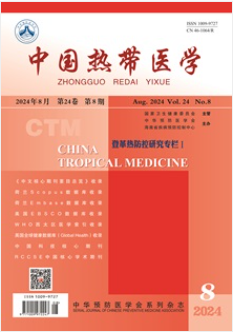广西104例吸毒前男男性接触者HIV非职业暴露后预防调查
引用次数: 0
摘要
目的了解广西2个城市104名男男性行为者(MSM)在接受非职业性暴露后预防(nPEP)前的艾滋病知识、行为特点、对nPEP的认识、使用nPEP的原因以及接受服务后行为改变的可能影响。方法在南宁市和柳州市通过社区宣传招募参与者。在接受HIV nPEP药物治疗前,对同意参与调查的MSM进行面对面问卷调查。P <0.05为差异有统计学意义,进行描述性分析。结果104名男男性行为者艾滋病知晓率为98.1%(102/104),84.6%(88/104)的人认为所在地区男男性行为者艾滋病流行严重。在过去6个月中,没有人在同性恋活动中每次都坚持使用避孕套,54.8%(57/104)的人经历过避孕套被性伴侣撕扯、滑落或故意拔出;64.4%(67/104)的女性在最近6个月内没有固定伴侣。88.5%(92/104)的人在调查前听说过新避孕措施,单因素分析显示,近一年来,新避孕措施知晓率与接受安全套推广/艾滋病自愿咨询检测及同伴教育的人数相比,差异有统计学意义(P <0.05)。69.2%(72/104)的人因担心接触HIV感染的可能性而接受了nPEP, 67.3%(72/104)的人因不了解性伴侣的HIV血清学状况而接受了nPEP。如果接受了nPEP,只有9.6%(10/104)的人认为安全套的使用会减少,15.4%(16/104)的人认为性伴侣的数量会增加。结论男男性行为者艾滋病知识与行动的分离需要采取以生物医学方法和行为干预为主的综合防治策略。应强调网络和非政府组织在新人与发展宣传中的作用,以提高目标人群对新人与发展的认识。摘要:目的分析广西南宁市,柳州市104名男男性行为者(与男性发生性关系的男性,男男同性恋者)在接受艾滋病非职业暴露后预防(非职业化接触后预防、nPEP)用药前的相关艾滋病知识掌握情况,行为学特征,nPEP知晓度,使用nPEP原因及接受服务后对行为改变可能产生的影响等。方法 在南宁、柳州市通过社区宣传倡导, 现场招募研究对象。这句话的意思是:“我的意思是我的意思是我的意思。”(1) . p < 0.05。结果104名MSM的艾滋病知晓率为98.1%(102/104);认为所生活地区MSM的人群中艾滋病毒流行严重的占84.6%(88/104)。最近半年同性性行为时能每次使用安全套的0人,54.8%(57/104)经历过安全套意外破裂,脱落或被性伴故意拔套,64.4%(67/104)最近半年内没有固定性伴.88.5%(92/104)调查前听说过nPEP,单因素分析发现,最近一年接受过安全套宣传与发放/艾滋病咨询与检测,最近一年接受过同伴教育对nPEP知晓差异有统计学意义(P < 0.05) .69.2%(72/104)选择nPEP因为担心此次暴露会感染艾滋病,67.3%(72/104)表示性伴感染状况未知。若接受nPEP,仅有9.6%(10/104)认为安全套使用会减少,15.4%(16/104)认为性伴数会增加。“。【中文翻译】本文章由计算机程序翻译,如有差异,请以英文原文为准。
Survey of 104 MSM before drug uptake of HIV non-occupational post-exposure prophylaxis in Guangxi
Objective This survey aims to understand AIDS knowledge, behavioral characteristics, awareness of non- occupational post-exposure prophylaxis (nPEP), and reasons for using nPEP, the possible impact on behavior change after receiving services among 104 men who have sex with men (MSM) prior to drug uptake of nPEP in 2 cities of Guangxi. Methods Participants were recruited through community advocacy in Nanning and Liuzhou. A face-to-face questionnaire survey was conducted on MSM who agreed to participate in investigation before taking medication of HIV nPEP. P <0.05 was considered statistically significant, and descriptive analysis was conducted. Results AIDS awareness of 104 MSM respondents reached 98.1% (102/104), and 84.6% (88/104) believed that the HIV prevalence was serious among MSM group in the area where they living. In the past six months, no respondents insisted on condom use each time during homosexual activities, and 54.8% (57/104) experienced condoms torn/ slipped or being deliberately pulled out by sexual partners; 64.4% (67/104) had no fixed partners in the last six months. 88.5% (92/104) had heard of nPEP before the survey, univariate analysis indicated that there was statistically significant difference between nPEP awareness and receiving condom promotion/AIDS voluntary counseling & testing as well as peer education in the past year ( P <0.05). 69.2%(72/104) received nPEP since worrying about the probability of HIV infection by the exposure, while 67.3% (72/104) took the service because they did not understand HIV serological status of sexual partners. If received nPEP, only 9.6% (10/104) believed that condom use would decrease, and 15.4% (16/104) thought the number of sexual partners would increase. Conclusion Separation between AIDS knowledge and action among MSM requires a comprehensive prevention and control strategy that emphasizes biomedical approaches and behavioral interventions. The role of networks and Non-Governmental Organization (NGO) in nPEP publicity should be highlighted to increase the awareness of nPEP among target population. 摘要: 目的 分析广西南宁市、柳州市 104 名男男性行为者(men who have sex with men, MSM)在接受艾滋病非职 业暴露后预防(non-occupational post-exposure prophylaxis, nPEP)用药前的相关艾滋病知识掌握情况、行为学特征、 nPEP 知晓度、使用 nPEP 原因及接受服务后对行为改变可能产生的影响等。 方法 在南宁、柳州市通过社区宣传倡导, 现场招募研究对象。对纳入艾滋病非职业暴露后预防并同意在服药前接受调查的 MSM 开展面对面问卷调查。以 P < 0.05 为差异有统计学意义,对资料进行描述性分析。 结果 104 名 MSM 的艾滋病知晓率为 98.1%(102/104);认为所生 活地区的 MSM 人群中 HIV 流行严重的占 84.6%(88/104)。最近半年同性性行为时能每次使用安全套的 0 人,54.8%(57/ 104)经历过安全套意外破裂、脱落或被性伴故意拔套,64.4%(67/104)最近半年内没有固定性伴。88.5%(92/104)调查 前听说过 nPEP,单因素分析发现,最近一年接受过安全套宣传与发放/艾滋病咨询与检测、最近一年接受过同伴教育对 nPEP 知晓差异有统计学意义( P <0.05)。69.2%(72/104)选择 nPEP 因为担心此次暴露会感染 HIV,67.3%(72/104)表示 性伴感染状况未知。若接受 nPEP,仅有 9.6%(10/104)认为安全套使用会减少,15.4%(16/104)认为性伴数会增加。 结论 MSM 存在艾滋病“知信行分离”,需采取生物医学干预技术和行为干预并重的综合性防治策略。重视网络和社 会组织在 nPEP 宣传中的作用,提高人群知晓率。
求助全文
通过发布文献求助,成功后即可免费获取论文全文。
去求助
来源期刊
CiteScore
0.60
自引率
0.00%
发文量
13927
期刊介绍:
China Tropical Medicine, was approved by the Ministry of Science and Technology in 2001, is the only tropical medicine periodical under the charge of the National Health Commission of China. It’s organized by Hainan Provincial Center for Disease Prevention and Control, and Chinese Preventive Medicine Association.
The journal is indexed by the following database: Scopus database, Embase database, EBSCO Database, The Western Pacific Region index medicus (WPRIM), American Chemical Abstracts (CA), International Centre for Agricultural and Biological Sciences Research Database (CABI), Global Health Database, Database of the Ulrich's Periodicals Directory, China Science and Technology Core Journals, China Core Journals (Selection) Database, Database of Chinese Biomedical Literature, Comprehensive Evaluation Database of Chinese Academic Journals, CAJCD Code of Conduct Excellent Journal, Database of Chinese SCI-Tech Periodicals, China Journal Full Text Database.

 求助内容:
求助内容: 应助结果提醒方式:
应助结果提醒方式:


